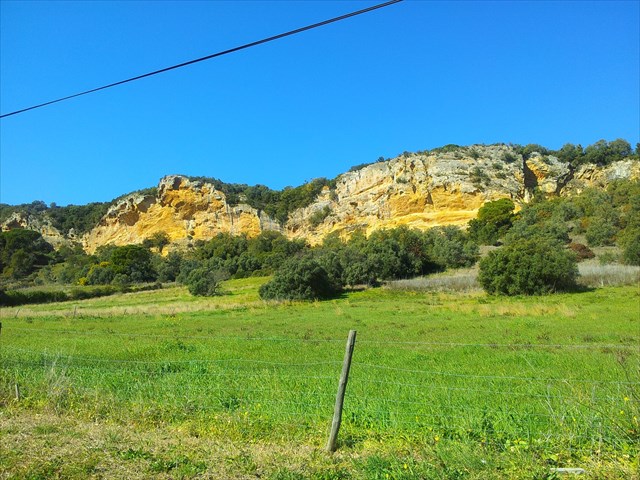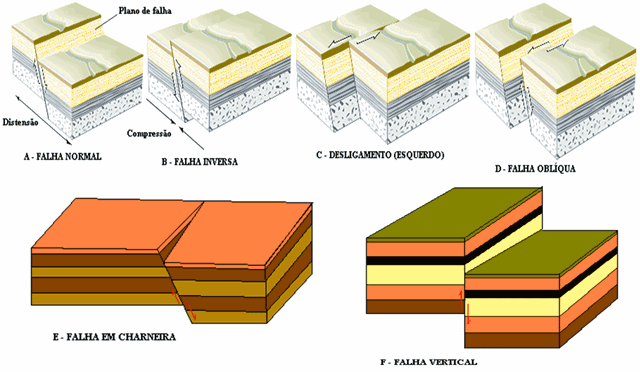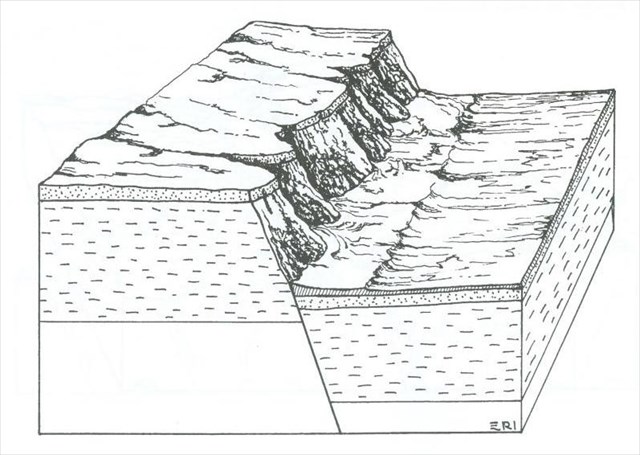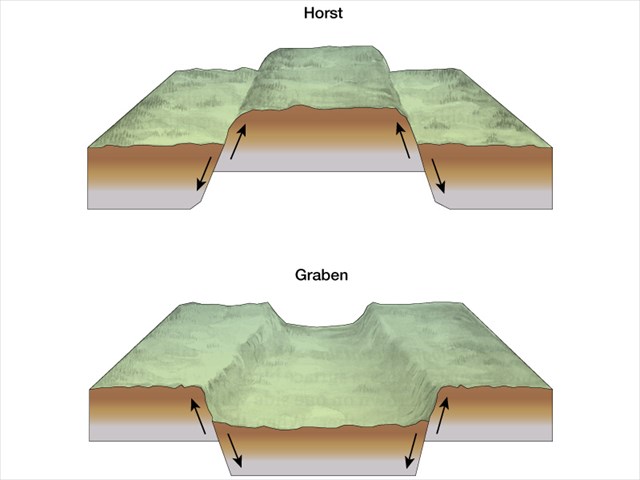A Falha da Serra de S. Luis
Ao percorrermos a estrada nacional 10 (N10), podemos não nos aperceber, mas do lado da Serra de S. Luis, encontra-se uma grande falha geológica com cerca de 1,3 Km de comprimento que vai desde a entrada para as pedreiras de S. Luis, até à entrada para a capela de S. Luis e é de notar as enormes dimensões que esta falha tem.


 Fracturas - Quando, sob tensão, uma rocha atinge o ponto de ruptura, fractura-se. Existem dois tipos principais de fracturas:
Fracturas - Quando, sob tensão, uma rocha atinge o ponto de ruptura, fractura-se. Existem dois tipos principais de fracturas:
- Diacláses - quando há fractura mas não existe movimento apreciável entre os dois blocos.
- Falhas - quando a fractura é acompanhada de movimentação de um bloco relativamente ao outro, paralela ao plano de falha.
Diacláses
As diacláses são o tipo de fractura mais comum. Pode dizer-se que estão presentes em praticamente todos os afloramentos.
As diacláses formam-se quando as rochas são sujeitas a qualquer tipo de tensão e, também, quando essas tensões deixam de se exercer. Assim, não são só os grandes campos regionais de tensões que geram diacláses. A erosão, ao remover as camadas geológicas superficiais alivia as tensões confinantes das rochas subjacentes, provocando, muitas vezes, o desenvolvimento de diacláses. Também as arribas marinhas, ao recuarem devido à actuação das ondas na sua base, provocam uma relaxação que, com frequência, conduz ao desenvolvimento de diacláses. Estas fracturas podem, também, desenvolver-se em rochas vulcânicas, devido às tensões que se desenvolvem quando a lava arrefece e diminui de volume.
O desenvolvimento de diacláses é, geralmente, apenas o início de uma longa série de transformações que vão afectar as rochas. Por exemplo, estas fracturas facilitam a penetração e circulação profundas do ar e da água, os quais aceleram a alteração das rochas. Por outro lado, as raízes podem penetrar, por vezes profundamente, pelas diacláses, provocando a sua abertura e fracturação suplementares.
As diaclases ocorrem em sistemas, havendo normalmente sistemas que se desenvolvem quando as rochas são submetidas a tensão, e outros que surgem quando essas tensões deixam de se exercer.
A intersecção dos sistemas de diacláses conduz, por vezes, à compartimentação da rocha em blocos mais ou menos geométricos.
Falhas
Uma falha é um acidente tectónico originado por fractura do terreno, ao longo da qual houve deslocamento relativo, maior ou menor, dos dois compartimentos contíguos.
As falhas desenvolvem-se quando as tensões (compressivas, distensivas ou tangenciais) que se exercem nas rochas ultrapassam o ponto de ruptura.
Existem três tipos principais de falhas:
- falhas normais - que se formam em ambientes distensivos
- falhas inversas - que se formam em ambientes compressivos
- falhas de desligamento - que se formam em ambientes de tensões tangenciais
Não é comum encontrar falhas "puras" deste tipo. Normalmente, quer as falhas normais, quer as inversas, têm alguma componente de desligamento.

A falha divide dois blocos, designados normalmente por bloco levantado e bloco abatido. As partes dos blocos adjacentes à falha chamam-se os lábios da falha.
O plano que divide os dois blocos tem o nome de plano de falha. Com frequência, os blocos ao deslizarem um pelo outro deixam marcas dessa movimentação no plano de falha. Essas marcas chamam-se estrias e são uma boa indicação do tipo de movimento que ocorreu. Por vezes, o plano de falha, devido à ficção e à temperatura atingidas aquando da movimentação (isto é, ao jogo da falha), fica bastante polido. Nestas condições, é costume dizer-se que existe um liso ou espelho de falha. Quando as falhas afectam massas de pirite, o espelho de falha permite mesmo, por vezes, a reflexão da imagem (quase como um espelho normal).
A falha é caracterizada essencialmente pela direcção e pela inclinação do plano de falha.
Devido à movimentação ocorrida na falha, dois pontos previamente adjacentes (ditos pontos homólogos) ficaram afastados de determinada distância. Essa distância é designada por rejeito da falha. É frequente utilizarem-se, também, as designações de rejeito horizontal (distância, na horizontal, que separa dois pontos homólogos), e rejeito vertical (distância, na vertical, que separa dois pontos homólogos). Como é evidente, a adição vectorial destes dois rejeitos dá o rejeito real.
Por vezes, a falha ao jogar, isto é, os blocos ao deslocarem-se um relativamente ao outro, fracturam-se em pedaços pequenos que ficam entre eles, e que mais tarde podem ser agregados por qualquer tipo de cimento (frequentemente carbonato precipitado pela água). Diz-se, então, que existe uma brecha de falha ou de fricção. Outras vezes, no plano de falha existem argilas, ditas argilas de falha ou, na terminologia mineira, "borracha").

Escarpa de Falha - Escarpas de falha são abruptos paredões que têm sua gênese no recente deslocamento vertical de blocos falhados. Nesta feiçãoa inclinação que constitui o bloco ascendente, coincide com o espelho de falhamento. No entanto, o desnível que arca o movimento dos blocos e as feições provocadas pelo deslocamento, são atenuados pela erosão que tende a aplainá-los.
A intersecção da falha com a superfície topográfica designa-se por traço de falha, o qual, muitas vezes, não é evidente devido à existência de solo e vegetação que o cobrem. No entanto, muitas vezes, as falhas adquirem expressão morfológica muito evidente, chegando a constituir desníveis notáveis. Nestes casos diz-se que existe uma escarpa de falha.
Normalmente, as falhas não ocorrem isoladamente mas sim em sistemas de falhas. A maior parte dos sistemas de falhas estão associados a campos de tensões relacionados com a tectónica de placas.
Por vezes ocorrem sistemas de falhas inversas, gerados por ambientes tectónicos compressivos, que fazem com que o comprimento central se eleve. São os chamados horsts, que são frequentes, por exemplo, nas zonas de fronteira de placas convergentes, quando há colisão continental. Os horsts conduzem a um encurtamento da crusta, isto é, constitui uma forma dos materiais se acomodarem a tensões fortemente compressivas.

Outras vezes, ocorrem sistemas de falhas normais, geradas por ambientes distensivos, na sequência do o compartimento central é abatido. São os grabens, frequentes, por exemplo, nas zonas em que se estão a instalar fronteiras de placas divergentes, isto é, onde está a ocorrer riftogénese. Perante um ambiente fortemente distensivo, os materiais acomodam-se no sentido de proporcionarem um alongamento da crusta.
_________________________________________________________________________________
Para registar a sua visita nesta cache precisa enviar-me um e-mail com as resposta às seguintes perguntas:
1 - Qual o ângulo de inclinação da falha no ponto da earthcache?
2 - Qual é +/- a altura da falha no ponto da earthcache?
3 - Qual é a falha que podemos visualizar no ponto da earthcache e explique por palavras suas o porque de ser essa falha?
The Fracture of S. Luis Mountain
When we walk along the national highway 10 (N10), we may not realize, but the side of S. Luis Mountain there is a great fault about 1.3 km long that extends from the entrance to the quarries of S. Luis, to the entrance to the chapel of S. Luis and is to note the huge dimensions that it has.

 Fractures - When under stress, a rock hits the break point, breaking up. Two main types of fractures:
Fractures - When under stress, a rock hits the break point, breaking up. Two main types of fractures:
- Diacláses - when no fracture but there is considerable movement between the two blocs.
- Failure - where the fracture is accompanied by movement of a block relative to the other, parallel to the plane of failure.
Diacláses
The diacláses are the most common type of fracture. You could say that are present in virtually all outcrops.
The diacláses form when the rocks are subjected to any tension, and also when such stresses cease to perform. So not only are large regional stress fields that generate diacláses. The Erosion, by removing the surface geological relieves the tensions of confining bedrock, causing often develop diacláses. Also marine cliffs, to recede due to wave action at its base, to cause a relaxation, often leads to the development of diacláses. These fractures can also develop in volcanic rocks, due to the stresses that develop when the washer decreases in volume and cooled.
The development of diacláses is generally just the beginning of a long series of changes that will affect the rocks. For example, these fractures facilitate the penetration depth and movement of air and water, which accelerate the change of the rocks. Moreover, the roots can penetrate deeply at times, by diacláses, causing the fracturing and additional opening.
The diaclases occur in systems, with systems which typically develop when the rocks are subjected to tension, and other stresses which arise when these are no longer performed.
The intersection systems diacláses sometimes leads to the subdivision into blocks of rock about geometries.
Fault
A fault is caused by an accident tectonically fractured land, along which there relative movement, larger or smaller of the two contiguous compartments.
The faults develop when tensions (compressive distensivas or tangential) that are exerted on the rocks beyond the breaking point.
There are three main types of faults:
Normal faults - which are formed in extensional environments
Reverse faults - that form in compressive environments
Fault shutdown - formed in environments of tangential stresses
It is common to find faults "pure" of this type. Normally, either the normal faults, or the reverse, have some component shutdown.

The fault separates two blocks, usually designated by raised block and block shot. The parties to the failure of adjacent blocks are called the lips of failure.
The plane that divides the two blocks is called the fault plane. Often the blocks slide by one another to make this move marks the fault plane. These marks are called striae and are a good indication of the type of movement that occurred. Sometimes the fault plane due to the fiction and the temperature reached during the movement (ie, the game's fault), it is quite polished. Accordingly, it is customary to say that there is a smooth or mirror fails. When faults affecting mass of pyrite, the mirror enables even failure sometimes reflection image (almost like a mirror normal).
The failure is essentially characterized by the direction and the tilt of the fault plane.
Due to the fault movement occurred in two adjacent points in advance (so-called homologous points) were kept away from certain distance. This distance is referred to as reject of the failure. Very often use is also the descriptions of reject horizontal distance (horizontally, that separates two points counterparts), and reject vertical (distance vertically separating two homologous points). Of course, the vector addition of two wastes gives the actual waste.
Sometimes, the failure to play, ie the blocks to move relative to one another, fracture into small pieces which lie between them, and which later can be aggregated by any type cement (usually carbonate precipitated by the water). It is said therefore that there is a hole or failure of friction. Other times, the fault plane are clays, clays said failure or, in the terminology mining, "rubber").
 Fault Scarp - fault scarps are steep cliffs that have their genesis in the recent vertical displacement of blocks failed. This feature is that the slope ascending the block coincides with the mirror of faulting. However, the gap which blocks the movement of the cabinet and the features caused by displacement, are attenuated by erosion, which tends to flatten them.
Fault Scarp - fault scarps are steep cliffs that have their genesis in the recent vertical displacement of blocks failed. This feature is that the slope ascending the block coincides with the mirror of faulting. However, the gap which blocks the movement of the cabinet and the features caused by displacement, are attenuated by erosion, which tends to flatten them.
The intersection of the fault with the land surface is called a trace of failure, which often is not obvious because of the presence of soil and vegetation that the cover. However, often the flaws acquire morphological expression, evidently, comes to constitute notable gaps. In these cases it is said that there is a slope of failure.
Normally, failures do not occur in isolation but fault systems. Most systems flaws are associated with stress fields related to the tectonic plate.
Sometimes reverse faults occur systems, environments tectonic generated by compression, to cause to rise the central length. These are called horsts, which are frequent, eg in the border zones of converging plates when there continental collision. The horsts lead to a shortening of the crust, that is, the material is a way to accommodate the compressive stress strongly.

Other times, there are systems of normal faults generated by extensional environments, following the central compartment is slaughtered. Grabens are frequent, eg in areas that are to be installed divergent plate border, ie where the riftogénese occur. Given a strongly extensional environment, materials accommodate themselves in order to provide a stretching of the crust.

_________________________________________________________________________________
To register your visit to this cache you need to send me an e-mail with the following questions:
1 - What is the inclination of the failure in the point of the earthcache?
2 - What is + / - the height of the failure in the point of the earthcache?
3 - What kind of fault are we present at the earthcache, and explain why.
